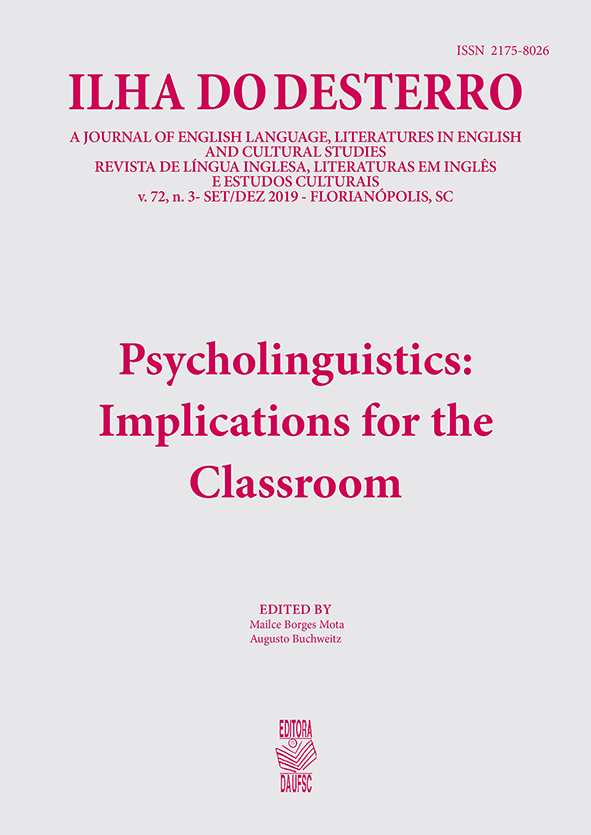Ao conhecer uma regra gramatical, os usuários L2 não são nativos
DOI:
https://doi.org/10.5007/2175-8026.2019v72n3p359Resumo
Neste trabalho, investigamos os efeitos da transferência de treinamento em bilíngues tardios do português-inglês do Brasil, em comparação com os nativos, em relação ao processamento da construção causativa-inglesa. Foram realizados dois experimentos: um focado na compreensão do padrão e o outro focado em sua produção. Os resultados de ambos os experimentos apontam para o fato de que a regra gramatical aprendida pelos bilíngues é apenas 'transferida' quando há tempo para implementá-la. No primeiro experimento, não encontramos nenhum efeito do treinamento; pelo contrário, os bilíngues podem ter sido afetados pela distribuição do SVO da construção correspondente em seu L1. No segundo experimento, no entanto, descobrimos que os bilíngues tinham altas taxas de uso da forma causal canônica, SAuxOV. Esse comportamento indica que os bilíngues não implementam a regra automaticamente. Em vez disso, sua implementação é vista em tarefas mais controladas. Assim, regras gramaticais explicitamente dadas parecem não ser aprendidas implicitamente, pois não são automatizadas para serem facilmente recuperadas no uso na vida real. Além disso, no que diz respeito à regra causal-ter, o comportamento linguístico dos bilíngues era mais semelhante ao dos nativos quando não implementavam a regra e usavam a forma SVO com um sentido causal.Referências
Alexander, L. (1990). Longman English grammar practice. London New York: Longman.
Azar, B. & Hagen, S. (2009). Understanding and using English grammar. White Plains, N.Y: Pearson Education.
Davies, Mark. (2008-) The Corpus of Contemporary American English (COCA): 560 million words, 1990-present. Available online at https://corpus.byu.edu/coca/.
Dulay, H. C., & Burt, M. K. (1973). Should we teach children syntax?. Language learning, 23(2), 245-258.
Dulay, H. C., & Burt, M. K. (1974). NATURAL SEQUENCES IN CHILD SECOND LANGUAGE ACQUISITION 1. Language learning, 24(1), 37-53.
Ellis, N. C. (2006). Selective attention and transfer phenomena in L2 acquisition: Contingency, cue competition, salience, interference, overshadowing, blocking, and perceptual learning. Applied Linguistics, 27(2), 164-194.
Ellis, N. C. (2008). The dynamics of second language emergence: Cycles of language use, language change, and language acquisition. The modern language journal, 92(2), 232-249.
Goldberg, A. E. (1995). Constructions: A construction grammar approach to argument structure. University of Chicago Press.
Goldberg, A. E. (2006). Constructions at work: The nature of generalization in language. Oxford University Press on Demand.
Krashen, S. (1994). The input hypothesis and its rivals. Implicit and explicit learning of languages, 45-77.
McCarthy, M., McCarten, J. & Sandiford, H. (2014). Touchstone. New York: Cambridge University Press.
Murphy, R. & Murphy, R. (2015). English grammar in use : a self-study reference and practice book for intermediate learners students of English. Cambridge: Cambridge University Press
Nassaji, H. (2017). Grammar acquisition. The Routledge handbook of instructed second language acquisition, 205-223.
Nation, I. S. P. (1990). Teaching and Learning Vocabulary. Teaching Methods. United States: Cengage Learning, Inc. Retrieved September, 9, 2017.
Nemser, W. (1971). Approximative systems of foreign language learners. IRAL-International Review of Applied Linguistics in Language Teaching, 9(2), 115-124.
Robinson, P., Mackey, A., Gass, S. M., & Schmidt, R. (2012). Attention and awareness in second language acquisition. The Routledge handbook of second language acquisition, 247-267.
Schmidt, R. (2010). Attention, awareness, and individual differences in language learning. In W. M. Chan, S. Chi, K. N. Cin, J. Istanto, M. Nagami, J. W. Sew, T. Suthiwan, & I. Walker, Proceedings of CLaSIC 2010, Singapore, December 2-4 (pp. 721-737). Singapore: National University of Singapore, Centre for Language Studies.
Segalowitz, N. (2010). Cognitive bases of second language fluency. Routledge.
Selinker, L. (1972). Interlanguage. IRAL-International Review of Applied Linguistics in Language Teaching, 10(1-4), 209-232.
Slabakova, R. (2014). The bottleneck of second language acquisition. Foreign Language Teaching and Research, 46(4), 543-559.
Sorace, A. (2011). Pinning down the concept of “interface” in bilingualism. Linguistic approaches to bilingualism, 1(1), 1-33.
Ullman, M. T. (2001). The neural basis of lexicon and grammar in first and second language: The declarative/procedural model. Bilingualism: Language and cognition, 4(2), 105-122.
Vilela, A.C. (2009). Transferência Linguística e Transferência de Treinamento na In- terlíngua do Falante de Português-L1 / Inglês-L2. (Master’s Thesis) . Retrieved from http://www.poslin.letras.ufmg.br/defesas/1239M.pdf.
Westney, P. (1994). Rules and pedagogical grammar. Perspectives on pedagogical grammar, 72-96.
Winter, B., & Reber, A. S. (1994). Implicit learning and the acquisition of natural languages. Implicit and explicit learning of languages, 115-145.
Downloads
Publicado
Edição
Seção
Licença
A revista Ilha do Desterro publica artigos e resenhas inéditos, referentes as áreas de Inglês, Literaturas em Língua Inglesa e Estudos Culturais. Publica volumes mistos e/ou temáticos, com artigos e resenhas em inglês e português.
Autores mantém os direitos autorais e concedem à revista o direito de primeira publicação, com o trabalho simultaneamente licenciado sob a Licença Creative Commons Attribution que permite o compartilhamento do trabalho com reconhecimento da autoria e publicação inicial nesta revista.

This work is licensed under a Creative Commons Attribution 4.0 International License.



